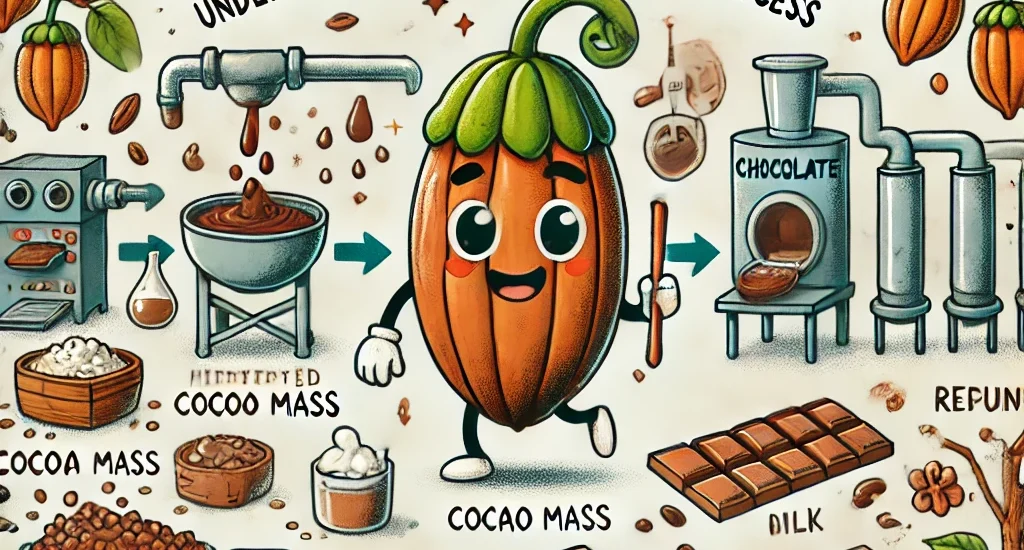Introduction
Chocolate may be one of the world’s most beloved treats, but few people know the complex and fascinating journey it takes from cacao bean to the final bar on store shelves. The chocolate-making process blends ancient traditions with modern technology and requires both scientific precision and artisan skill.
This article walks through each stage of chocolate production—from harvesting cacao pods to crafting the perfect chocolate bar—highlighting the craftsmanship, chemistry, and care involved in every step.
1. Cultivation and Harvesting of Cacao
Where Cacao Grows
Cacao (Theobroma cacao) thrives in the “cacao belt”, a tropical zone within 20 degrees of the equator. Major producers include:
- Ivory Coast and Ghana (West Africa)
- Ecuador, Peru, and Brazil (South America)
- Indonesia and Philippines (Asia)
Harvesting
- Cacao pods are harvested by hand using machetes or knives to avoid damaging the tree.
- Each pod contains 20–50 cacao beans surrounded by a sweet white pulp.
- Pods are collected and split open within a few days to avoid fermentation starting inside the pod.
2. Fermentation
Purpose of Fermentation
Fermentation is critical for developing chocolate flavor precursors.
- Beans and pulp are placed in wooden boxes or baskets and covered with banana leaves.
- Fermentation typically lasts 5–7 days, during which natural yeasts and bacteria break down the pulp.
- Heat generated during fermentation kills the bean and initiates flavor development.
Results
Proper fermentation enhances the chocolate’s complexity, reduces bitterness, and contributes to color and aroma.
3. Drying
After fermentation, beans are sun-dried for 5–10 days.
- Beans are spread out on drying mats or platforms and turned regularly to ensure even drying.
- Moisture content is reduced from ~60% to below 7%.
This stage preserves the beans for storage and shipping, and improper drying can lead to mold or off-flavors.
4. Roasting
Once beans arrive at a chocolate factory, they are sorted and roasted to develop flavor.
- Roasting temperatures vary between 110–160°C (230–320°F) depending on bean type and desired flavor profile.
- Time and temperature influence final taste—longer roasting can produce nuttier or deeper notes.
- Roasting also loosens the outer shell, making it easier to remove during the next step.
5. Winnowing
After roasting, beans are cracked and the outer husks are removed in a process called winnowing.
- This separates the valuable cacao nibs from the inedible shells.
- The nibs, rich in cocoa solids and cocoa butter, are the basis for all chocolate products.
6. Grinding and Cocoa Liquor Production
Nibs are ground into a thick, liquid paste known as cocoa mass or cocoa liquor.
- The heat generated during grinding melts the cocoa butter, forming a liquid.
- This liquor can be pressed to separate cocoa solids (used in cocoa powder) from cocoa butter.
The balance of these components determines the type of chocolate (dark, milk, or white).
7. Blending Ingredients
For most chocolate, additional ingredients are added:
- Sugar: Balances the bitterness of cocoa.
- Milk powder: Used in milk chocolate to add creaminess.
- Vanilla or lecithin: Enhance flavor and improve texture.
Formulas vary widely between manufacturers and chocolate types.
8. Conching
Conching is the process of refining and aerating chocolate to develop a smooth, luxurious texture.
- Chocolate is heated and mixed continuously in conching machines for up to 72 hours.
- This reduces particle size and evaporates undesirable acids or volatiles.
High-quality chocolate often undergoes longer conching, resulting in superior mouthfeel.
9. Tempering
Tempering aligns the cocoa butter crystals in chocolate for gloss, snap, and stability.
- Chocolate is carefully heated and cooled to precise temperatures.
- Proper tempering prevents fat bloom and gives chocolate a shiny, smooth appearance.
Tempered chocolate is essential for chocolate bars, pralines, and molded products.
10. Molding and Packaging
The final liquid chocolate is poured into molds and cooled.
- Chocolate is set in refrigerated rooms and then demolded.
- It’s packaged in foil, wrappers, or boxes depending on the brand and product type.
Packaging often plays a key role in protecting the chocolate and expressing the brand identity.
Conclusion
From tropical farms to artisan kitchens, the chocolate-making process is a meticulous journey combining agriculture, chemistry, engineering, and culinary art. Understanding how chocolate is made deepens our appreciation for every bite and reminds us of the countless hands and steps involved in transforming a humble bean into a world-famous treat.





